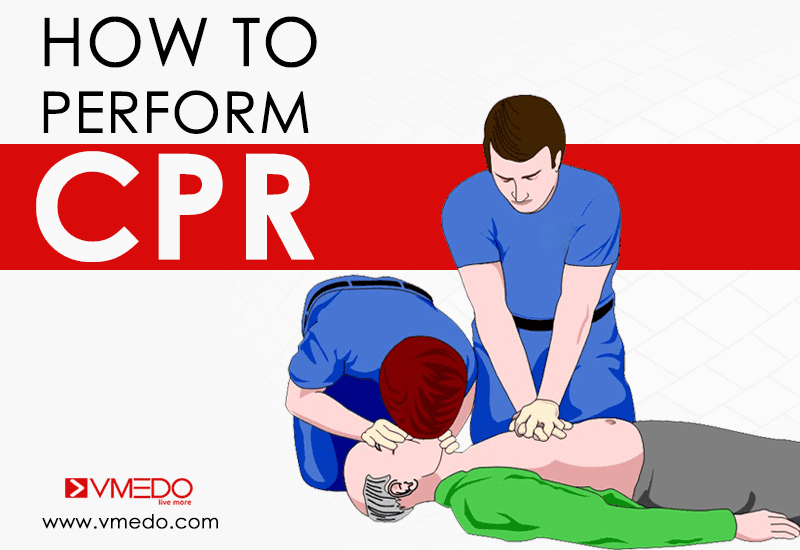CPR is an emergency lifesaving procedure useful in heart attack, drowning conditions where someone’s breathing or heartbeat has stopped.
It’s far better to do something in emergencies to save a life than doing nothing. Your effort of doing something could save someone’s life.
Some useful tips to perform CPR:
- If you are not trained in CPR, then perform hands-only CPR i.e., performing uninterrupted chest compression of about 100-120 per minute.
- If you are trained in CPR, then perform chest compression at first then check and open the airway and perform rescue breathing/ mouth to mouth breathing. Perform one cycle CPR i.e., 30 chest compression & then check the airway & give 2 rescue breaths.
Check the following things before beginning CPR:
- Check whether the person is in the safe place with proper ventilation.
- Whether the person is breathing, conscious or unconscious? And check the pulse not more than 10 seconds to know about the heartbeat.
- If the person appears to be unconscious call emergency ambulance services helpline and start the CPR.
- If AED (Automated External Defibrillator) is available immediately, deliver one shock and then resume CPR.
In CPR, CAB is the common abbreviation that helps people in performing different steps of CPR. CAB stands for Compression, airway & Breathing.
Chest Compression:
To Restore the blood flow circulation
- Place/ keep the person on a firm flat surface.
- Kneel next to the victim’s side.
- Place the heel of your one hand at the center of the person’s chest. Place your other hand above the first & interlace your fingers.
- Make use of your body weight and push down the person’s chest for at least 2 inches and give chest compression at a rate of about 100 to 120 compression per minute.
- Continue giving chest compression until any signs of movement. And if you are trained in CPR then continue Checking airway & rescue breathing.
Open the airway:
- If you are trained in CPR, then perform the next steps. Perform 30 chest compression’s & open the person’s airway by placing your palm on person’s forehead and gently tilt their head back, and with the other hand gently forward the chin to open the airway.
- Check & listen to normal breathing sounds for about 5 to 10 seconds. Check their chest motion & breathing sound on your cheek & ear. If the person is not breathing normally, then begin mouth to mouth breathing only if you are trained in CPR. If you are not trained in handling emergency situations, continue chest compressions.
Rescue Breathing: (Mouth To Mouth Breathing)
Rescue breathing includes mouth to mouth breathing or mouth to nose breathing if the mouth can’t be opened or seriously injured.
- Pinch the victim’s nostrils and close the person’s mouth with yours & making it a seal to provide mouth to mouth breathing.
- Give two rescue breaths. The first breath for 1 second & check if the chest rises. If the chest rises then give second breath and if the chest doesn’t rise, repeat head-tilt, chin-lift maneuver and then give the second breath. 30 chest compression followed by 2 rescue breaths are considered as 1 cycle in CPR. Do not provide too much breath at a time and with too much force.
- Resume chest compression to restore circulation.
- If the person has not shown any signs of improvement after 5 cycles of CPR, then if AED (Automated External Defibrillator) available, administer 1 shock, follow the process and resume the CPR starting with chest compression, for 2 minutes and then administer the 2nd shock. If you don’t know about the usage of AED, ask medical operator assistance. If AED is not available then go to next step.
- Continue CPR until some signs of improvement or till medical operator arrives.
CPR on a Child (1-8 year)
The Procedure for CPR on a child (1-8 year) is the same as adults. The steps are as follows:
- Perform about 5 cycles of CPR for about 2 minutes on the child, each cycle should take 18-20 seconds. Call Ambulance helpline immediately.
- Use both the hands or if the child is too small use single hand for chest compression. Push down the chest for about 2 inches.
- Follow the same compression-breathe rate as used for adults. That is 30 chest compression followed by 2 mouth to mouth breathing. This is called 1 CPR cycle.
- Perform about 5 cycles of CPR and check any signs of improvement. Use Automated External Defibrillator (AED) if available & follows the process. Do not use AED for babies younger than 1 year ago. Administer one shock and resume CPR right from starting with chest compression and rescue breathing for two more minutes before administering the second shock. If you are not trained in using AED ask the medical operator assistance to use it.
- Continue CPR until any signs of improvement or till medical operator arrives.
CPR on a baby:
Many a time cardiac arrest in babies occurs due to lack of oxygen from drowning or choking. If the baby is not breathing due to airway obstruction then perform first aid for choking. And if you don’t know the real cause for not breathing then perform CPR for babies.
- Call ambulance services & perform CAB procedures.
- Perform 5 cycles of chest compression and rescue breaths on the child.
Chest compression:
- Place the child on a flat surface.
- Use 2 fingers of your hand and gently push the chest for about 1.5 inches at the rate of 100 to 120 compressions per minute.
Open & clear the airway:
- After 30 chest compression, tilt the head back & lift the chin in one hand and push down the forehead with another hand.
- Check babies breathing and its chest motion. Place your ear & chin near baby’s mouth to listen & feel baby’s breath.
Breathe for Baby:
- Seal the baby’s mouth with yours & close the nostrils through your hand.
- Gently give two rescue breaths for the baby each of 1 second and check if the baby’s chest rises. If the chest rises continue giving 2nd If the chest doesn’t rise, then continue giving head-tilt, life-chin maneuver & give the second breath.
- Check the baby’s mouth to check for any obstruction in a baby’s mouth. If an object is seen sweep it through your finger. If the material is blocking the airway, then perform first aid for choking.
- Give 2 breaths for every 30 compressions for the baby & continue performing CPR until medical help arrives.
If you are looking for first aid, CPR, AED, and Basic Life Support training program Click here and Register.




Very Useful Content